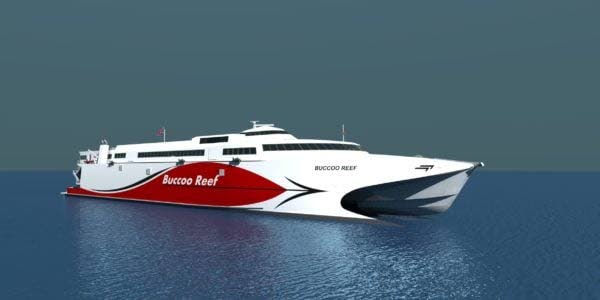Leaking pumps halted Buccoo Reef's voyage

Leaking pumps were the reason the US$72.9 million Buccoo Reef fast ferry had to turn back during its voyage to TT in January.
National Infrastructure Development Company (Nidco) chairman Herbert George said the repairs should be complete by the end of February for the vessel to restart its journey.
George made the disclosure during a joint select committee meeting on the company’s operations on Monday. He said when alarms went off on the vessel on its way to its first port of call, Tahiti, the decision was made to return it to the builders, INCAT Tasmania Pty Ltd, in Australia.
George said when it returned to the shipyard, it was found that the cooling water pump had sprung a leak. The pump was reinstalled by the original manufacturer, MAN, but on sea trial it was found that another pump had sprung a leak, and this was also replaced.
“What they found was that the filter of the pumps was being clogged with foreign matter, and that foreign matter, whatever it was, in that high-pressure, high-temperature environment, becomes very abrasive. So that is what was causing the seals of the pumps to be damaged.
"They then decided to replace all four pumps, which had to be shipped from Germany, and that took a while because of the restrictions in place for covid19.
"They arrived last Thursday and are being installed, but before they are installed, the technicians were instructed to flush all the engines to ensure no other foreign matter was present in the cooling system.”
Responding to a question from committee member David Lee, George said while the engines from the Buccoo Reef and the APT James are identical, the latter had not experienced similar problems.
“The workmanship on one might have been different. So those people who worked on the APT James were more thorough in flushing out their engines before they installed the pumps, but in the second case things fell through the cracks and maybe the pumps were installed on engines that were not properly flushed.
"That’s my best assessment of what happened with the Buccoo Reef, and not really an indictment on the engines per se, but it would probably have to do with the workmanship.”
George said the engine manufacturers had been co-operative about replacing the parts, and all the work was being done under guarantee.
“We have a consultant presence on the ground in Australia looking at our interests. He’s a marine engineer that we’ve used previously.
"At the end of the day we want a sea trial witnessed by our man on the ground and we will be furnished with the records of that sea trial and those must be to everyone’s satisfaction before the Buccoo Reef sets sail again.”


Comments
"Leaking pumps halted Buccoo Reef’s voyage"